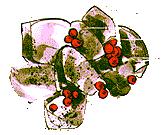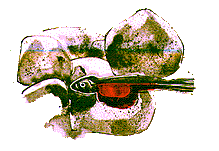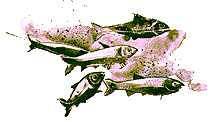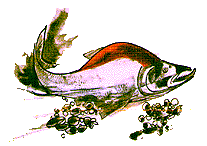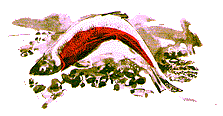Biology
Kokanee salmon belong to the same species as sockeye salmon (Oncorhynchus nerka), but when sockeye migrate to the ocean to grow to maturity, Kokanee remain in lakes. Sockeye are referred to as anadromous fish while Kokanee are landlocked. Many lakes and streams in BC support both Kokanee and sockeye; sometimes they spawn side by side. Others support only sockeye or only Kokanee. Present scientific information suggests that Kokanee arose from sockeye in each system into which sockeye established a population. After the last ice age some 10,000 years ago, Columbia River sockeye are suggested to have migrated into what is now the Okanagan, and established a sockeye population. Kokanee populations then evolved off the sockeye population. Later, when access upstream into the Okanagan was blocked, the sockeye population disappeared, leaving the Kokanee population we see today. Similar patterns of Kokanee establishment are suggested for the Arrow and Kootenay lake systems. Thus the Kokanee of Okanagan Lake are more related to sockeye of the Columbia River than to the Kokanee of Kootenay Lake. This implies that each lake’s Kokanee population is evolved for that specific lake, and is therefore uniquely adapted to that lake.
Okanagan Lake supports two types of Kokanee salmon – the stream spawners and the lake shoreline spawners or beach spawners. During their entire feeding life the two types mix in the lake. At sexual maturity, usually at age three (three years after being laid as eggs), they undergo a spawning migration, spawn, and die. Stream-spawners migrate into some 14 lake tributaries in early September and complete spawning by mid-October. Shore-spawners migrate to spawning beaches along the lake shoreline and spawn from mid-October to mid-November. ( Fig 1 )
The two types of Kokanee appear to be reproductively isolated. Recovery of spawning adults that were tagged during their fry outmigration from Mission Creek suggested most returned to their natal area, some strayed to other tributaries, but none spawned along the lake shoreline. Study of genetic material (mitochondrial DNA) enabled no genetic separation of fish among tributaries, or among shore-spawning areas, but separation between stream and shore ecotypes. If combined with their temporal and spatial separation at spawning this evidence strongly suggests that shore-spawning and stream-spawning Kokanee are distinct populations.
- scientific name: Oncorhynchus nerka kennerlyi
- “Kokanee” is a native word meaning “red fish”
- a type of sockeye salmon
- referred to as “landlocked” sockeye salmon because they spend their entire life in freshwater differing from the anadromous sockeye salmon which spends part of its life in the river and then the ocean, after which it returns to its home river to spawn
- native to British Columbia, Alaska, Washington, Idaho, Siberia and Japan
- Okanagan, Kalamalka and Wood lakes are unique in that they have both stream and shore spawning populations of Kokanee salmon
- two distinct populations of Kokanee salmon in the Okanagan: stream spawners and shore spawners
- common names in the Okanagan Valley: Kokanee, kickininee, little redfish, landlocked salmon, Kennerly’s salmon, silver trout, yank
Appearance
- silver on sides with a bluish-black top and white on stomach
- body color changes during spawning season
- those that change the most have green heads and bright red sides
- 3 layers of muscle in salmon body — white, pink, red
- red or lateral muscle: found along sides, just under skin
- high fat content used in steady, untiring swimming activity during migration
- scales are embedded in the skin and protected by a thick coat of mucus
- smaller than the ocean sockeye salmon
Hearing
- fish hearing is limited to sound waves in water
- pores in a canal run along the sides of the salmon contain motion sensitive hair cells. This structure is called a lateral line
- functions:
- senses water movement
- detects moving objects
- used in schooling
Vision
- salmon have no eye lids
- the pupil of the eye is large and does not change shape like in humans so the salmon tend to avoid bright light
- they can perceive colors
Smell
- they detect odors by using sacs inside the snout
- these organs of scent are known as an olfactory system and are used for:
- predator avoidance
- migration direction
- mate choice
Biology: Life Cycle
1. FOOD SUPPLY
Kokanee compete for zooplankton with species such as the freshwater shrimp (Mysis relicta), Rainbow trout, whitefishes, northern squawfish and suckers. A low food supply reduces the Kokanee growth rate resulting in insufficient body reserves to survive their first winter.
2. PREDATION ON KOKANEE
Large Rainbow trout feed exclusively on Kokanee, therefore the Kokanee must avoid the trout in order to survive.
3. NUTRIENTS
Most of the decaying vegetation and other waste products carried down by the streams during spring runoff are in a form not immediately available for plant growth.
Such materials may settle out before they are decayed, and they become locked in the bottom sediments of a lake and therefore can not be utilized.
The level of Okanagan Lake’s productivity is known as being oligotrophic (nutrient poor).
4. AGE DETERMINATION
Scales & otoliths (inner ear bones) are used to determine the age of a salmon.
The scales of the salmon grow and as they do they form rings just like those of a tree trunk.
These rings form bands which can be counted. The widely spaced rings occur in the spring and summer months when food supply is abundant, while the more tightly packed rings indicate the winter months when growth is slow from limited food supply.
Life Cycle
Hatching
Alevin Stage
Fry Stage
Silver Stage
Maturation
Digging a Redd
Fertilization
Illustrations by Murray Johnson







